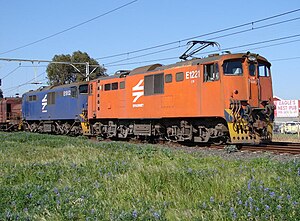South African Class 6E

No. E1221 approaching Bellville station, Cape Town, 1 September 2006
|
|||||||||||||||||||||||||||||||||||||||||||||||||||||||||
|
|||||||||||||||||||||||||||||||||||||||||||||||||||||||||
|
|||||||||||||||||||||||||||||||||||||||||||||||||||||||||
|
|||||||||||||||||||||||||||||||||||||||||||||||||||||||||
|
|||||||||||||||||||||||||||||||||||||||||||||||||||||||||
| Type and origin | |
|---|---|
| Power type | Electric |
| Designer | Union Carriage and Wagon |
| Builder | Union Carriage and Wagon |
| Model | UCW 6E |
| Build date | 1970 |
| Total produced | 82 |
| Specifications | |
|---|---|
| AAR wheel arr. | B-B |
| UIC class | Bo'Bo' |
| Gauge | 3 ft 6 in (1,067 mm) Cape gauge |
| Wheel diameter | 1,220 mm (48.0 in) |
| Wheelbase | 11,279 mm (37 ft 0.1 in) |
| • Bogie | 3,430 mm (11 ft 3.0 in) |
| Pivot centres | 7,849 mm (25 ft 9.0 in) |
| Panto shoes | 6,972 mm (22 ft 10.5 in) |
| Length: |
|
| • Over couplers | 15,494 mm (50 ft 10.0 in) |
| • Body | 14,631 mm (48 ft 0 in) |
| Width | 2,896 mm (9 ft 6.0 in) |
| Height: |
|
| • Pantograph | 4,089 mm (13 ft 5.0 in) |
| • Body height | 3,937 mm (12 ft 11.0 in) |
| Axle load | 22,226 kg (49,000 lb) |
| Adhesive weight | 88,904 kg (196,000 lb) |
| Loco weight | 88,904 kg (196,000 lb) |
| Power supply | Catenary |
| Current collection | Pantographs |
| Traction motors | Four AEI-283AZ |
| • Rating 1 hour | 623 kW (835 hp) |
| • Continuous | 563 kW (755 hp) |
| Gear ratio | 18:67 |
| Loco brake | Air & Regenerative |
| Train brakes | Air & Vacuum |
| Couplers | AAR knuckle |
| Performance figures | |
|---|---|
| Maximum speed | 113 km/h (70 mph) |
| Power output: |
|
| • 1 hour | 2,492 kW (3,342 hp) |
| • Continuous | 2,252 kW (3,020 hp) |
|
Tractive effort: |
|
| • Starting | 311 kN (70,000 lbf) |
| • 1 hour | 221 kN (50,000 lbf) |
| • Continuous | 193 kN (43,000 lbf) @ 40 km/h (25 mph) |
| Career | |
|---|---|
| Operators | South African Railways Iscor Spoornet Transnet Freight Rail |
| Class | Class 6E |
| Power class | 3 kV DC |
| Number in class | 82 |
| Numbers | SAR E1146-E1225 Iscor F221.01-F221.02 |
| Delivered | 1970-1971 |
| First run | 1970 |
The South African Railways Class 6E of 1970 is an electric locomotive.
In 1970 and 1971, the South African Railways placed eighty Class 6E mainline electric locomotives with a Bo-Bo wheel arrangement in service. Two more were built for Iscor, for use at the Sishen iron ore mine.
The 3 kV DC Class 6E electric locomotive was designed and built for the South African Railways (SAR) in 1970 by Union Carriage and Wagon (UCW) in Nigel, Transvaal, with the electrical equipment supplied by Associated Electrical Industries (AEI) and English Electric (EE).
Eighty locomotives were delivered to the SAR in 1970 and 1971, numbered in the range from E1146 to E1225. UCW did not allocate builder’s or works numbers to the locomotives it built for the SAR, but used the SAR unit numbers for their record keeping.
In 1970, two Class 6E locomotives were also built new by UCW for Iscor (now Kumba), for use at the Sishen Iron Ore Mine in the Northern Cape. Numbered Iscor F221.01 and F221.02, these two were allocated UCW works numbers 6E.58 and 6E.59 respectively.
These dual cab locomotives have a roof access ladder on one side only, just to the right of the cab access door. The roof access ladder end is marked as the no. 2 end. A corridor along the centre of the locomotive connects the cabs, which are identical, apart from the fact that the handbrake is located in cab 2. A pantograph hook stick is stowed in a tube mounted below the lower edge of the locomotive body, on the roof access ladder side. The locomotive has three small panels along the lower half of the body on the roof access ladder side, and only one panel on the opposite side.
In respect of body dimensions and shape, the Class 6E locomotive is identical to the last batch of Class 5E1, Series 5 locomotives, with their squared body corners. The most obvious visual external difference from the Class 5E1, is the replacement of the three small vertically arranged grilles, to the right of centre on each side of the Class 5E and Class 5E1, with a larger double grille on the Class 6E. In respect of the coachwork, the Class 6E is identical to its immediate predecessor, the Class 6E1, Series 1, while its bogies are identical to those of the Class 5E1.
Compared to the Class 5E1, the Class 6E had improved traction motors, particularly with regard to the insulation of the windings. This resulted in a continuous power output of 563 kilowatts (755 horsepower) per traction motor and a total continuous power output of 2,252 kilowatts (3,020 horsepower) per locomotive, compared to the 364 kilowatts (488 horsepower) per traction motor and 1,456 kilowatts (1,953 horsepower) total of the Class 5E1.
...
Wikipedia
